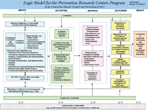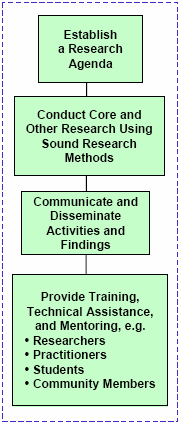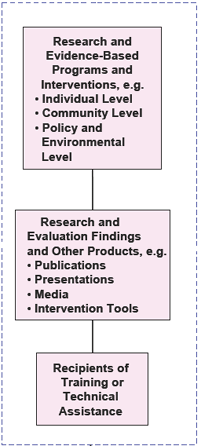Description of the Logic Model for the Prevention Research Centers (PRC) Program
The logic model for the PRC Program was developed to describe the activities of the program and the outcomes it expects to achieve. The model identifies the inputs, activities, outputs, outcomes, and impact common to all PRCs and shows the expected relationships among these components. The diagram of the model summarizes how the program is presumed to work. Although the boxes of the model are shown in a linear fashion, the relationships among them are expected to be complex and interactive over time.
Logic Model for the PRC Program

Logic Model for the PRC Program [PDF - 254KB]
Inputs

Activities

The second column of the logic model describes activities of the PRCs, which include establishing a research agenda, conducting research, communicating and disseminating activities and findings, and providing training, technical assistance, and mentoring. The activities column also includes two overarching activities of a PRC: The evaluation box and the engage the community box.
Outputs

Outcomes

The fourth column of the logic model includes the outcomes, or the intended effects of the program activities. PRCs can vary in the order in which their outcomes occur.
Translation of Research to Practice and Policy and Widespread Use of Evidence-Based Programs and Policies
An expected outcome is the uptake of research that results in changes to public health practice and policies. Research conducted by the PRCs is expected to be translated into community practice or policies adopted by local and state health departments, schools, other public agencies (e.g., recreation departments, housing authorities), and community-based organizations. Over time, these interventions and policies may be disseminated beyond a PRC’s defined community and gain widespread use.
Enhanced Community Capacity for Health Promotion and Disease Prevention
One purpose of the PRC Program is to build capacity for public health practice. Therefore, an expected outcome is enhanced community capacity for health promotion and disease prevention. Enhanced capacity includes an increased ability on the part of agencies and organizations to implement and make well-reasoned decisions about effective health promotion and disease prevention programs and services. This capacity combines a community’s commitment, resources, and skills to respond to public health needs and priorities.
Skilled Public Health Professionals and Community Members
An expected outcome of the PRC Program is the development of skilled public health professionals and community members. Those who collaborate with PRCs to implement research projects and who participate in PRC-sponsored training and technical assistance improve their skills as a result, and are better able to implement effective programs and interventions.
Expanded Resources
Over time, as a PRC reaches its goals and outcomes, the center can grow beyond the core funding and initial faculty, staff, and partnerships. New projects and funding complement or build on the PRC’s core research or expand the center’s work into new areas.
Increased Recognition and Support
A PRC may gain local, regional, or national recognition from a community or organization for expertise in a particular field, for contribution to a public health topic or practice, or for its involvement with a community or partner. Recognition and dissemination of the PRCs’ work can lead to increased support for the PRC Program and prevention research overall.
Impact

The last column of the logic model, impact, is defined as the future, long-term change the program is working to create, or the ultimate goal of the PRC program.
Improved Community and Population Health and Elimination of Health Disparities
As shown in the one box in the impact column, the ultimate goal of the PRC Program is to contribute to improved community and population health and to eliminate health disparities. The work of the PRCs contributes to this impact along with the work of many other partners and programs.
Contextual Conditions

The box across the bottom of the entire logic model implies that there are contextual conditions, such as socioeconomic, political, and cultural factors, that are external to the PRC Program and may not be within its control, but these conditions may influence the implementation of activities and the achievement of outcomes. These conditions may relate to all components of the model, as shown by the one-way arrows that lead to each column of the logic model (i.e., inputs, activities, outputs, outcomes, and impact).
- Page last reviewed: March 30, 2016
- Page last updated: March 30, 2016
- Content source:


 ShareCompartir
ShareCompartir